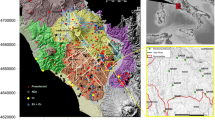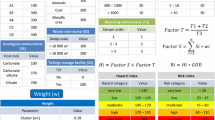Abstract
Results of comprehensive geochemical mapping and thematic studies of the Slovak territory (rocks, soils, stream sediments, groundwaters, biomass, and radioactivity) in the first half of the 1990s led to several new research programmes in Slovakia, within the frame of which new methodologies for geochemical data evaluation and map visualization were elaborated. This study describes the application and elaboration of data from the Geochemical Atlas of the Slovak Republic at national and regional levels. Based on the index of environmental risk (IER = ΣPEC/PNEC), the level of contamination for the geological component of the environment in Slovakia was evaluated. Approximately 10.5% of Slovakia’s territory was characterized as being environmentally disturbed to highly disturbed. In the areas where environmental loadings have accumulated, 14 regions where environmental risks existed due to high element concentrations were defined. The model calculations of health risk estimates based on the databases of the Geochemical Atlas for groundwater and soils indicate that the possible risk occurrence of carcinogenic diseases from groundwater arsenic contents is high in more than 10% of Slovakia, whereas the chronic risk is negligible. To determinate the background and threshold levels a combined statistical–geochemical approach was developed and applied as an example for groundwater at the national level as well as for single groundwater bodies. The results of statistical method application for the whole groundwater body (GBW) were compared with the background values for anthropogenically non-influenced areas in GBW. Final background value took into account time variations and spatial distribution of the element in GBW. Furthermore, based on the database from the Geochemical Atlas for groundwater, groundwater bodies potentially at qualitative risk were delineated for the whole of Slovakia. From a total of 101 groundwater bodies 17 were characterized as being at risk and 22 as being at possible risk.








Similar content being viewed by others
References
Anon (1994) ROZHODNUTIE MP SR, č. 531/1994-540 o najvyšších prípustných hodnotách škodlivých látok v pôde a o určení organizácií oprávnených zisťovať skutočné hodnoty týchto látok. Vestník MP SR XXVI 1:3–10
Anon (2000) Directive 2000/60/EC of the European Parliament and of the Council of 23 October 2000 establishing a framework for Community action in the field of water policy
Anon (2004) VYHLÁŠKA MZ SR č. 151/2004 Z.z. o ožiadavkách na pitnú vodu a kontrolu kvality pitnej vody
Babiaková G, Bodiš D, Rapant S, Rončák P, Závodský D (1996) Problematika mapovania kritických záťaží a ich prekročení pre povrchové a podzemné vody. Vodohospodársky časopis 44(2–3):103–117
Backman B, Bodis D, Lahermo P, Rapant S, Tarvainen T (1998) Application of a groundwater contamination index in Finland and Slovakia. Environ Geol 36(1–2):55–64
Bodiš D (2003) Mapa súčasného chemického stavu útvarov podzemnej vody. Manuskript, archív SHMU, Bratislava, 34
Bodiš D (2006) Influence of the land use on soil contamination in the Spišsko-gemerské Rudohorie Mts. Mineralia Slovaca 38/1:29–36
Bodiš D (2007) Návrh stanovenia pozaďových a prahových hodnôt v podzemnej vode. Mineralia Slovaca 39/3:181–189
Bodiš D, Rapant S (2000) Environmental geochemistry and environmental—geochemical mapping of the Slovak Republic. Slovak Geol Mag 6(1):5–16
Bodiš D, Babiaková G, Rapant S, Rončák P, Závodský D (1995) Mapping critical loads/exceedances: natural waters of Slovakia. Slovak Geol Mag 1(1):71–76
Bodiš D, Rapant S (eds), Khun M, Klukanová A, Lexa J, Marsina K, Pramuka S, Vozár J (1999) Geochemical Atlas of the Slovak Republic—part VI. Stream sediments. Monograph, Ministry of the Environment of the Slovak Republic, Bratislava, 146
Bodiš D, Lopašovská M, Lopašovský K, Rapant S (2000) Chemické zloženie snehovej pokrývky na Slovensku—výsledky 25-ročného pozorovania. Podzemná voda VI./2000 2:162–173
Brezsnyánszky K, Malík P, Gaál G, Kordík J (2006) Environmental state and sustainable management of Hungarian-Slovakian transboundary groundwater bodies (ENWAT). INTERREG IIIA Neigbourhood Programme Hungary—Slovakia—Ukraine. MÁFI Budapest, Geological Survey of the Slovak Republic, Bratislava
BRIDGE http://www.wfd-bridge.net
Čurlík J, Šefčík P (1999) Geochemical Atlas of Slovakia—part V. Soils. Monograph, Ministry of the Environment of the Slovak Republic, Geological Survey of Slovak Republic, Bratislava, 98
Daniel J, Lučiviansky L, Sterz M (1996) Geochemical Atlas of Slovakia—part IV. Natural radioactivity of rocks. Monograph, Ministry of the Environment of the Slovak Republic, Geological Survey of Slovak Republic, Bratislava, 88
Darnley AG (1990) International geochemical mapping: a new global project. J Geochem Explor 39:1–13
Darnley AG (1994) Global geochemical baselines: recommendations for international geochemical mapping. In: Abstracts—3rd international symposium on environmental geochemistry, 12–15 September 1994, Kraków, Poland, pp 95–96
Darnley AG, Bjorklund A, Bølviken B, Gustavsson N, Koval PV, Plant JA, Steenfelt A, Tauchid M, Xie xuejing. (1995) A global geochemical database for environmental and resource management. Earth Sciences 19, UNESCO Publishing
Erhardt W, Höpker KA, Fischer I (1998) Verfahren zur Bewertung von immissionsbedingten Stoffanreicherungen in standardisierten Graskulturen. Umweltchem Őkotox 8:237–240
Fordyce FM, Vrana K, Zhovinsky E, Povoroznuk V, Toth G, Hope BC, Iljinsky U, Baker J (2007) A health risk assessment for fluoride in Central Europe. Environ Geochem Health 29(2):83–102
Förstner U, Ahlf W, Calmano W, Kersten M (1990) Sediment criteria development. In: Heling D, Rothe P, Förstner U, Stoffers P (eds) Sediments and environmental geochemistry. Springer, Heidelberg, pp 311–338
Helsel DR, Hirsch RM (1992) Statistical methods in water resources. Elsevier, US Geol Survey, Water Resources Division Reston, Virginia 22092, 522
Kaplan EL, Maier P (1958) Nonparametric estimation from incomplete observations. J Am Stat Assoc 53:457–481
Khun M, Jurkovič Ľ, Urminská J (2000) A brief outline of the problems and practical application in region of Žiarska kotlina basin. Slovak Geol Mag 6(1):17–26
Malík P, Švasta J (2006) Charakterizácia útvarov podzemných vôd z hľadiska tvorby podzemných vôd, ich odvodňovania a smerov prúdenia podzemných vôd. Manuskript—archív ŠGÚDŠ, Bratislava, 121
Maňkovská B (1996) Geochemical Atlas of Slovakia—part II. Forest biomass. Monograph, Ministry of the Environment of the Slovak Republic, Geological Survey of Slovak Republic, Bratislava, 87
Marsina K, Bodiš D, Havrila M, Janák M, Káčer Š, Kohút M, Lexa J, Rapant S, Vozárová A (1999) Geochemical Atlas of Slovak Republic—part III. Rocks. Monograph, Ministry of the Environment of the Slovak Republic, Geological Survey of Slovak Republic, Bratislava, 134
Matschullat J, Ottenstein R, Reimann C (2000) Geochemical background—can we calculate it? Environ Geol 39(9):990–1000
Rapant S, Bodiš D (1995) Chemical time bombs—proposed method for the map presentation. Slovak Geol Mag 1(1):65–69
Rapant S, Kordík J (2003) An environmental risk assessment map of the Slovak Republic: application of data from Geochemical Atlases. Environ Geol 44(4):400–407
Rapant S, Krčmová K (2007) Health risk assessment maps for arsenic groundwater content: application of national geochemical databases. Environ Geochem Health 29(2):131–141
Rapant S, Vrana K, Bodiš D (1996) Geochemical Atlas of Slovakia—part I. Groundwater. Monograph, Ministry of the Environment of the Slovak Republic, Geological Survey of Slovak Republic, Bratislava, 127
Rapant S, Rapošová M, Bodiš D, Marsina K, Slaninka I (1999) Environmental—geochemical mapping program in the Slovak Republic. J Geochem Explor 66(2):151–158
Rapant S, Vrana K, Čurlík J (2004) Environmentálne riziko z kontaminácie geologických zložiek životného prostredia Slovenskej republiky (Environmental risk from the contamination of geological components of the environment of theSlovak Republic). Monography, Geological Survey of Slovak Republic, Bratislava, 80
Reimann C, Garrett RG (2005) Geochemical background—concept and reality. Sci Total Environ 350:12–17
Reimann C, Filzmoser P, Garrett R (2005) Background and threshold: critical comparison of methods of determination. Sci Total Environ 346:1–16
Salminen R (Chief-editor), Batista MJ, Bidovec M, Demetriades A, De Vivo B, De Vos W, Duris M, Gilucis A, Gregorauskiene V, Halamic J, Heitzmann P, Lima A, Jordan G, Klaver G, Klein P, Lis J, Locutura J, Marsina K, Mazreku A, O’Connor PJ, Olsson SÅ, Ottesen R-T, Petersell V, Plant JA, Reeder S, Salpeteur I, Sandström H, Siewers U, Steenfelt A, Tarvainen T (2005) Geochemical Atlas of Europe. Part 1: background information, methodology and maps. Geological Survey of Finland, Espoo, p 526
US EPA (1989a) Risk assessment guidance for Superfund (RAGS): vol I—Human Health Evaluation Manual (HHEM), part A: baseline risk assessment, interim final. United States Environmental Protection Agency, Office of Emergency and Remedial Response, Washington, DC (EPA/540/1–89/002)
US EPA (1989b) Exposure factors handbook. Office of Health and Environmental Assessment, (EPA/600/8–89/43)
US EPA (1991) Risk Assessment Guidance for Superfund (RAGS), vol I: Human Health Evaluation Manual (HHEM)—supplemental guidance, interim final. United States Environmental Protection Agency, Office of Emergency and Remedial Response, Washington, DC (OSWER 9285.6–03)
US EPA (1998) National water quality inventory—1998. United States Environmental Protection Agency, Report to Congress: Office of Water, 41
US EPA (1999) A risk assessment—multiway exposure spreadsheet calculation tool. United States Environmental Protection Agency, Washington, DC
US EPA (2000) Nutrient criteria technical guidance manual: rivers and streams. United States Environmental Protection Agency, EPA 822/B-00/002. 141
Vrana K, Malík P (2003) EU Nitrate Directive—identification of vulnerable zones in the territory of Slovakia. In: Productional and environmental aspects of nitrogen use in agricultural land. Findings of heretofore research in China and Slovakia. Soil Science and Conservation Research Institute, Bratislava
Vrana K, Rapant S, Bodiš D, Marsina K, Lexa J, Pramuka S, Maňkovská B, Čurlík J, Šefčík P, Vojtaš J, Daniel J, Lučivianský L (1997) Geochemical Atlas of the Slovak Republic at a scale 1:1,000,000. J Geochem Explor 60(1):7–37
Author information
Authors and Affiliations
Corresponding author
Rights and permissions
About this article
Cite this article
Rapant, S., Bodiš, D., Vrana, K. et al. Geochemical Atlas of Slovakia and examples of its applications to environmental problems. Environ Geol 57, 99–110 (2009). https://doi.org/10.1007/s00254-008-1286-0
Received:
Accepted:
Published:
Issue Date:
DOI: https://doi.org/10.1007/s00254-008-1286-0




